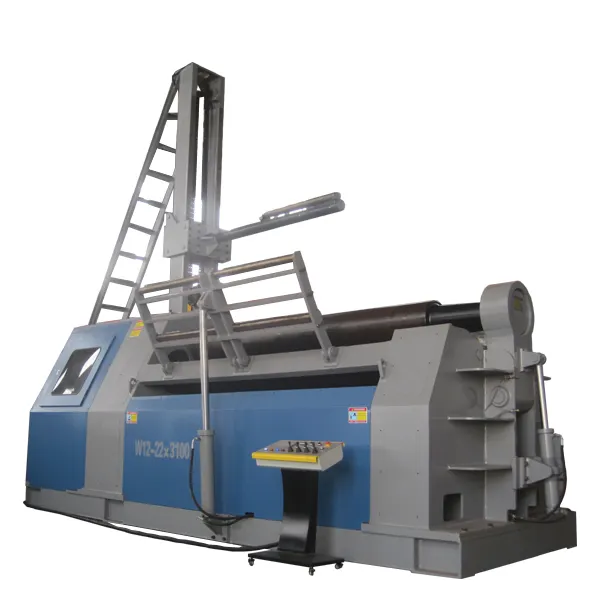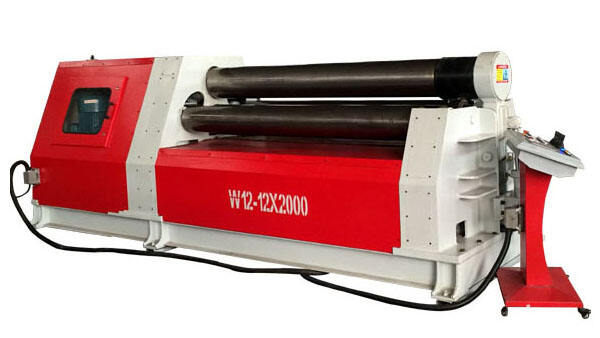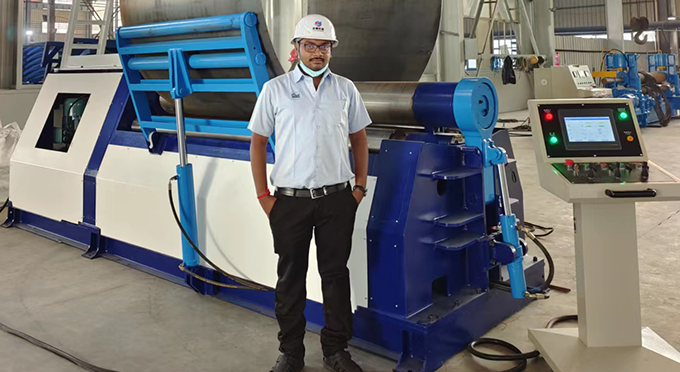Inaccurate Bending and Curvature Control in Plate Rolling Machines
Understanding the causes of inaccurate bending: Material properties and roller geometry
Inconsistent plate curvature often stems from mismatched material behavior and mechanical design. A 2023 Metal Forming Institute study revealed that 62% of bending errors originate from two key factors:
- Material yield strength variations (±15% in ASTM A36 steel batches directly impact springback)
- Roller geometry mismatches (under-crowned rollers causing 0.3–1.2mm deviations in 10mm thick plates)
These variables disrupt force distribution during rolling, leading to unpredictable curvature and increased rework.
Case Study: Fixing inconsistent curvature in carbon steel plate rolling
A European manufacturer reduced curvature defects by 40% in API 5L X70 pipeline production by upgrading to laser-aligned backup rollers with 0.01mm positional accuracy and integrating real-time thickness gauges. This allowed automatic adjustments for material batch variations, significantly improving repeatability across long production runs.
Strategy: Calibrating pre-bend settings and optimizing back-up roll positioning
| Calibration Parameter | Pre-Optimization | Post-Optimization |
|---|---|---|
| Initial pinch force | 85% of target | 98–102% range |
| Roll gap parallelism | ±0.25mm | ±0.08mm |
| Pre-bend angle | Manual adjustment | CNC-controlled compensation |
Automated deflection compensation systems now maintain angular deviation below 0.5° across 12m-long plates, ensuring consistent geometry even under high loads.
Trend: How CNC controls reduce human error and improve bend precision
Modern CNC interfaces eliminate 70% of manual calculation errors (Journal of Manufacturing Systems, 2024) by integrating extensive material databases (800+ alloy profiles), using closed-loop feedback from laser trackers during asymmetric rolling, and applying predictive springback algorithms—achieving 97% accuracy in stainless steel under 6mm thickness.
Hydraulic System Failures and Preventative Maintenance Solutions
Identifying Common Signs of Hydraulic Issues in Plate Rolling Machines
Early detection minimizes costly downtime. Operators should watch for irregular rolling speeds, unresponsive controls, or sudden pressure drops. Visible leaks, hissing sounds near seals, and overheating actuators—particularly above 160°F (71°C)—are strong indicators of developing issues. Thermal imaging shows such overheating correlates with 34% of industrial hydraulic failures.
Hydraulic Oil Leakage and Contamination: Root Causes and Immediate Fixes
Most leaks happen because seals have gotten old and brittle over time or because fittings weren't tightened properly during installation. When it comes to pump problems, dirt and grime are usually to blame. Statistics show contamination causes around three out of four pump failures, often coming from water getting into the system or tiny bits of metal floating around inside. To fix these issues quickly, maintenance teams should replace those worn out seals with the special high temp Viton versions when possible. Installing those little desiccant breathers along the lines helps keep moisture at bay too. And don't forget regular checks either. A good rule of thumb is to analyze the fluid onsite about every 500 hours of operation just to make sure the oil hasn't thinned out or picked up too many particles.
Preventative Maintenance: Seals, Filters, Fluid Analysis, and Pump Reliability
A structured 12-month maintenance plan reduces hydraulic failures by 61% (Industrial Maintenance Journal 2024). Key intervals and actions are:
| Component | Maintenance Interval | Key Action |
|---|---|---|
| Rotary Seals | 6 months | Inspect for extrusion, replace if worn |
| Suction Filters | 3 months | Clean or replace at 25 psi differential |
| Gear Pumps | Annual | Measure volumetric efficiency loss |
Adding predictive vibration analysis helps detect cavitation or bearing wear before failure occurs.
Case Study: Minimizing Downtime from Pump Failure in Heavy-Duty Rolling Operations
A steel fabrication plant cut hydraulic-related downtime by 83% after implementing dual-pump redundancy and quarterly oil sampling. When their primary pump failed mid-operation on a 1" thick stainless steel roll, the backup system maintained production while technicians replaced worn gerotor gears in just 4.2 hours—down from a previous average of 12 hours.
Uneven Rolling, End Flare, and Roller Alignment Challenges
Why Uneven Rolling and End Flare Occur During Plate Forming Processes
Uneven rolling and end flare result from asymmetric forces during forming. Thickness variations (±0.5 mm) and uneven yield strength create localized stress points, while roller deflection under load leads to non-uniform pressure along the plate length. This often produces tapered edges—observed in 17% of mild steel jobs (FMA 2023).
The Impact of Roller Misalignment and Wear on Edge Deformation
Misalignment as small as 0.3° increases edge deformation by 48% (ASM Metals Handbook 2024), especially with high-strength alloys. Worn rollers exceeding 0.8 mm deviation alter contact patterns, causing reverse bending at edges, “orange peel” surface texture, and stress concentrations that exceed fatigue limits.
Solution: Using Crowning Systems and Deflection Compensation for Uniform Rolls
Adaptive crowning systems counteract deflection by pre-shaping rollers with a 0.1–0.3% curvature profile tailored to material thickness. Combined with laser alignment (±0.02 mm accuracy), these systems reduce end flare by 82% in aluminum trials (Journal of Materials Processing Tech 2024). Regular alignment checks and wear monitoring remain essential for sustained performance.
Slip, Skidding, and Wrinkling: Causes and Operational Fixes
Mechanisms Behind Roll Slippage, Material Wrinkling, and Surface Tearing
When there's an imbalance in friction between rollers and the material being worked on, slippage occurs along with various surface defects. Thin metals such as aluminum and stainless steel tend to develop wrinkles whenever the pulling force gets stronger than what the material can handle before deforming, which leads to those unsightly buckles. Tearing at the surface typically appears when the grip is too strong for the metal to withstand, especially noticeable in tougher alloys that resist stretching. Getting the roller texture right matters a lot here too. Factory floor experience shows that about one out of every five production stoppages related to slippage problems actually comes down to either incorrect roller patterns or leftover coolant buildup messing up the contact points.
Insufficient Bending Force and Its Effect on Traction and Grip Control
Low bending force compromises roller grip, increasing skidding risk—especially with thick materials (¥20 mm), where inadequate clamping fails to overcome springback. Carbon steel requires 15–20% higher clamping force than aluminum of the same gauge. Real-time load monitoring detects deviations as low as 5%, enabling early correction.
Best Practices: Surface Preparation and Roll Grip Optimization
Three proven methods enhance grip and reduce defects:
- Laser-etched roller surfaces increase friction by 30–40% without damaging finishes
- Isopropyl alcohol wiping removes oil residues that impair traction
- Taper tension protocols gradually increase force across the width to prevent edge buckling
Field trials show combining these techniques reduces wrinkling by 68% in automotive chassis production.
Balancing High-Tension Rolling With Thin-Material Integrity
Excessive tension risks permanent deformation in thin plates (¤3 mm). To maintain integrity:
- Use multi-stage rolling with incremental force adjustments
- Employ annealed materials to improve ductility
- Install load-sensitive rollers that auto-adjust grip pressure
This approach ensures ±0.1 mm accuracy while preventing tears—critical for aerospace and electronics applications requiring micron-level precision.
Electrical, Control, and Vibration Issues in Plate Rolling Machines
Diagnosing Electrical Malfunctions: Fuses, Relays, and PLC Errors
Electrical failures commonly stem from blown fuses (due to surges or shorts), degraded relays, or PLC errors causing unresponsive or erratic machine behavior. Corroded terminals and outdated firmware account for 68% of unplanned stops linked to electrical faults (2023 industrial analysis).
Modern Diagnostics: IoT Sensors and Predictive Maintenance Integration
IoT sensors now monitor voltage, current, and temperature in real time, feeding data into predictive algorithms that flag anomalies like bearing wear or pressure drops before failure. One facility reduced repair costs by 32% in 2022 using vibration sensors paired with cloud analytics to proactively replace high-risk components.
Sources of Vibration and Noise: Overloading, Resonance, and Component Wear
| Vibration Cause | Common Symptoms | Operational Impact |
|---|---|---|
| Overloading | Irregular rolling speed | Premature roller wear |
| Resonance frequencies | Persistent humming noise | Misalignment of plates |
| Worn bearings/gears | Grinding during rotation | Reduced bending precision |
Resonance occurs when operational speed matches the machine's natural frequency, amplifying vibrations. Drive gear wear alone accounts for 45% of noise complaints in older machines.
Maintenance Strategy: Bearings, Gears, and Alignment Checks to Reduce Vibration
A three-step protocol effectively minimizes vibration:
- Monthly alignment verification using laser tools to ensure ±0.05mm roller parallelism
- Quarterly bearing inspections via ultrasonic testing to identify early fatigue
- Bi-annual gear lubrication with heavy-duty, high-viscosity grease
Facilities following this strategy reported a 57% reduction in vibration-related rejects (2024 data from 12 metal fabrication plants).
FAQ
Q: What causes inconsistent curvature in plate rolling machines?
A: Inconsistent curvature is often caused by variations in material yield strength and mismatches in roller geometry, disrupting force distribution during rolling.
Q: How can one fix inconsistent curvature in carbon steel plate rolling?
A: Upgrading to laser-aligned backup rollers and integrating real-time thickness gauges allow automatic adjustments for material batch variations, reducing defects.
Q: What are the signs of hydraulic issues in plate rolling machines?
A: Irregular rolling speeds, unresponsive controls, sudden pressure drops, visible leaks, and overheating actuators are common indicators of hydraulic problems.
Table of Contents
-
Inaccurate Bending and Curvature Control in Plate Rolling Machines
- Understanding the causes of inaccurate bending: Material properties and roller geometry
- Case Study: Fixing inconsistent curvature in carbon steel plate rolling
- Strategy: Calibrating pre-bend settings and optimizing back-up roll positioning
- Trend: How CNC controls reduce human error and improve bend precision
- Hydraulic System Failures and Preventative Maintenance Solutions
- Identifying Common Signs of Hydraulic Issues in Plate Rolling Machines
- Hydraulic Oil Leakage and Contamination: Root Causes and Immediate Fixes
- Preventative Maintenance: Seals, Filters, Fluid Analysis, and Pump Reliability
- Case Study: Minimizing Downtime from Pump Failure in Heavy-Duty Rolling Operations
- Uneven Rolling, End Flare, and Roller Alignment Challenges
- Slip, Skidding, and Wrinkling: Causes and Operational Fixes
- Electrical, Control, and Vibration Issues in Plate Rolling Machines




